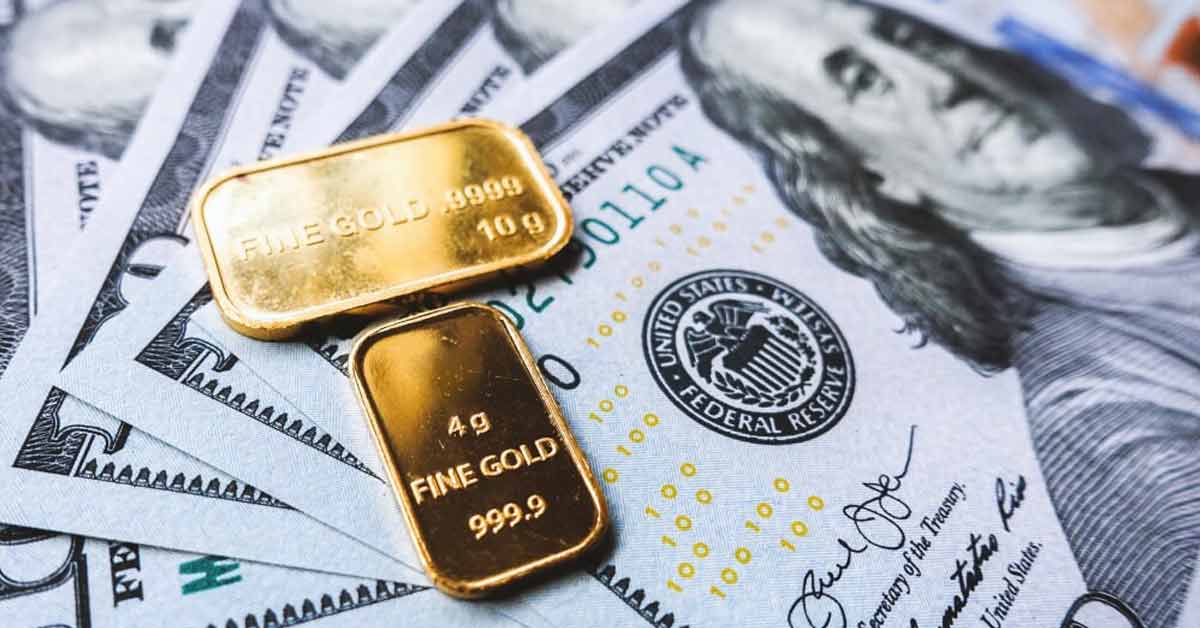ⓘ Disclaimer: The information in this article is for educational purposes only and does not constitute financial advice. Forex trading carries risks; please consult a professional before investing.
Gold is a modern society’s wealth. However, since the Stone Age, the value of gold has only seen one trend: upward value.

Well, once, it was used as a primary medium of currency. Nowadays, it is no longer a currency medium.
However, if you are from the investment industry, you know that gold influences the value of currencies including USD. So, we can consider it as a critical medium of foreign exchange.
Notably, in the late 70s, governments used gold to back fiat money. After that, a fixed cost was set per unit of gold to back paper money. Therefore, the fixed price is the value of a currency.
Nowadays, gold is not used to back paper money, but countries use gold as a foreign exchange reserve.
in the foreign market, gold is priced based on USD which makes the relation between these two more interesting.
Gold and the U.S. Dollar (USD) works inversely. That means, when the price of USD gets low compared to other currencies, the demand of gold increases. As a result, the price of gold also increases based on the increased demand.
Also, gold retains more value than paper money. This is why most forex inventors consider it a safe haven. For them, understanding the correlation and causation between gold and the USD is essential for developing effective trading strategies. If you are trading through https://roboforex.com/beginners/info/charts/metals/xauusd/, you need to be cautious about different factors and scenarios.
- Geopolitical risks
- Interest rates
- Inflation
- Market sentiment
So, it is time to gain more insight into gold and USD for seamless forex trading.
Understanding Gold and USD in Forex Markets
Gold is often referred to as a “safe-haven” asset, as its value tends to rise during times of economic uncertainty or geopolitical turmoil. The U.S. Dollar, on the other hand, is the world’s primary reserve currency and is widely used for global trade and investment. Both of these assets are influenced by a variety of factors, and understanding their dynamics is crucial for traders looking to capitalize on their movements.
Gold in the Forex Market
Gold has traditionally been viewed as a store of value and a hedge against inflation and currency devaluation. As a commodity, it is typically priced in USD, meaning that fluctuations influence its value in the dollar’s value relative to other currencies.
In times of inflation or economic instability, investors often flock to gold as a safe haven, driving up its price. Conversely, when the economy is stable and confidence in fiat currencies like the USD is high, gold’s price tends to decrease.
Some of the key factors that influence the price of gold include:
Inflation
Gold is often used as a hedge against inflation as inflation erodes the purchasing power of fiat currencies. Therefore, investors seek to preserve their wealth with gold.
In such conditions, people start buying gold which creates higher market demands. And as a result, the price of gold increases rapidly. These days, inflation is a critical fear for most people. So, the increase in the price of gold has been frequent recently.
Interest Rates
When interest rates are low, the opportunity cost of holding gold decreases, making it more attractive to investors. On the other hand, higher interest rates can make gold less appealing compared to interest-bearing assets.
Geopolitical Risk
Political instability, conflicts, or crises can trigger natural saving conditions for people. So, they try to find a safe haven with commodities like gold to save as much as possible.
USD Strength
Gold is priced in USD, meaning that a stronger dollar tends to push gold prices lower. Conversely, a weaker dollar can lead to higher gold prices. Therefore, gold is critically dependent on dollars.
The U.S. Dollar (USD) in the Forex Market
The USD is the world’s primary reserve currency and plays a dominant role in global trade and investment. The strength or weakness of the USD has a significant impact on the value of other currencies, as well as commodities like gold, oil, and agricultural products.
Several factors influence the U.S. Dollar’s value. Want to know?
Don’t worry! We have got you covered this time.
Interest Rates and Fed Policy
The U.S. Federal Reserve’s monetary policy, especially its decisions on interest rates, plays a significant role in determining the strength of the dollar. When the Fed raises interest rates, the USD tends to strengthen as investors seek higher returns. Conversely, a cut in interest rates can weaken the dollar.
Economic Data
Economic indicators like GDP growth, unemployment figures, and retail sales have a direct impact on the USD. Strong economic data tends to boost the dollar, while weak data can have the opposite effect.
Trade Balance
The U.S. trade balance, or the difference between imports and exports, can influence the demand for the dollar. A trade surplus can lead to a stronger USD, while a trade deficit can have the opposite effect.
Geopolitical Events
Like gold, the USD is also impacted by geopolitical events. During times of uncertainty, the dollar can benefit from its status as a global reserve currency as investors flock to the safety of USD-denominated assets.
The Correlation Between Gold and USD
The relationship between gold and the U.S. Dollar is often characterized by an inverse correlation, meaning that when the USD strengthens, gold typically weakens, and vice versa. This negative correlation arises because gold is priced in USD, so when the value of the dollar rises, it takes fewer dollars to buy the same amount of gold.
However, the correlation is not always perfect. Several factors can impact both gold and the USD in different ways, making the relationship more dynamic. For instance, if inflation is rising but the dollar is strengthening due to high interest rates, gold may still rise as a hedge against inflation. Conversely, if geopolitical risks cause global instability, both gold and the USD may see an increase in demand as investors seek safe-haven assets.
Historical Performance and Correlation
Historically, the correlation between gold and the USD has been negative.
Did you know that?
However, the strength of this correlation varies over time.
For instance, during periods of economic uncertainty, such as the global financial crisis of 2007-2008, both gold and the USD saw increased demand as investors sought safe-haven assets.
In contrast, during periods of strong economic growth, the inverse correlation tends to be more pronounced, with gold prices falling as the USD strengthens.
The Role of Inflation and Interest Rates
One of the most important factors influencing both gold and the USD is inflation. In times of high inflation, investors often turn to gold as a store of value, driving up its price. At the same time, inflation can erode the purchasing power of the USD, making gold a more attractive asset. When the Federal Reserve raises interest rates in an attempt to combat inflation, the USD tends to strengthen, and this can put downward pressure on gold prices.
However, the relationship between gold and the USD is not always straightforward. For example, if the Fed raises interest rates to curb inflation but economic growth slows significantly, the USD may still strengthen as investors flock to USD-denominated assets. In this case, gold may continue to rise as a hedge against the negative effects of inflation and economic instability.
Causation Between Gold and USD: Is it Always Inverse?
While the correlation between gold and the USD is often negative, causation is a different matter. Causation refers to the cause-and-effect relationship between two variables. On the other hand, correlation simply measures the relationship between them.
In the case of gold and the USD, the correlation can be seen as a result of various macroeconomic factors rather than a strict cause-and-effect relationship.
For instance, a rise in U.S. interest rates typically strengthens the USD and reduces the appeal of gold, leading to a drop in gold prices. This is a case where interest rates (a fundamental factor) are the causal force, driving both the USD and gold prices in opposite directions. On the other hand, both gold and the USD can benefit from geopolitical instability or economic crises, suggesting that, in some cases, they may be influenced by the same underlying cause.
To give you a clearer idea, here is another condition!
Causation in the gold-USD relationship can be seen during times of economic uncertainty. In these situations, investors often seek safety in both the U.S. Dollar and gold. The dollar’s status as the world’s reserve currency and the liquidity it provides can drive demand for USD-denominated assets.
At the same time, gold’s reputation as a store of value and a hedge against inflation can drive demand for the metal. In such cases, the causal factors can drive both assets higher.
- Economic instability
- Market sentiment
- Geopolitical risks
Well, even though their traditional inverse relationship is there, causation effects may hold less relevance.
Trading Strategies for Gold and USD in Forex
Understanding the interplay between gold and the USD is essential for developing effective Forex trading strategies. Here are some key strategies to consider:
1. Trend Following
One of the simplest and most effective strategies is to follow the prevailing trend in gold and the USD. If the U.S. Dollar is strengthening due to rising interest rates or strong economic data, gold may experience downward pressure.
Traders can use technical analysis tools, such as moving averages or trendlines, to identify the direction of the trend and enter trades accordingly.
2. Inflation and Interest Rate Hedging
Traders can also use gold and the USD to hedge against inflation and changes in interest rates. If inflation is rising and the Federal Reserve is likely to hike interest rates, traders may look to buy gold while simultaneously shorting the USD.
This strategy can work well when inflation is anticipated to outpace the Fed’s rate hikes, causing both gold and the USD to move in opposite directions.
3. Geopolitical Event Trading
Geopolitical events, such as wars, elections, or financial crises, can create volatility in both gold and the USD. Traders can take advantage of this by positioning themselves for safe-haven buying.
If a crisis occurs, traders can expect both gold and the USD to appreciate, and they can trade based on the expectation of risk-off sentiment.
4. Diversification and Risk Management
Given the negative correlation between gold and the USD, traders can diversify their portfolios by holding positions in both assets. This strategy can help mitigate risk, as gold and the USD often behave differently under varying economic conditions.
For instance, during periods of inflation, gold may rise while the USD falls, but during periods of economic growth, the USD may strengthen, putting downward pressure on gold.
5. Using Correlation in Cross-Currency Pairs
Traders can also use the correlation between gold and the USD to trade cross-currency pairs. For example, if the USD is strengthening and gold is falling, traders might look for short opportunities in USD/JPY or EUR/USD.
Conversely, if gold is rising due to economic instability and the USD is weakening, traders may consider buying gold against a weaker currency, like the Japanese Yen (XAU/JPY).
Conclusion
Now you know that the relationship between gold and the USD is complex and dynamic. And it goes far from our understanding when it comes to forex trading.
However, as of now, we have considered both key players, correlation, and causation, in the gold: USD game. The interactions and roles are different, but they are both crucial for dealing with commodities and currencies in foreign markets.
However, for forex traders, understanding the interplay between gold and the USD is critical. This particular understanding will help you go beyond casual investors and let you make strategies while noticing risks.
If you want to invest in forex you need to stay attuned to the economic factors related to it. You need to understand that our world runs on gold and USD. As a trader, you must have a solid understanding of their relations.
It is time to make informed, profitable decisions! Good luck with your future investments in Forex.
ⓘ As part of our ongoing support for startups and SMEs, LAFFAZ Media publishes feature and resource articles that may include references and links to external websites. These inclusions are selected at our editorial discretion to provide valuable information to our readers. LAFFAZ Media does not control, endorse, or assume responsibility for the content or practices of external websites. For more details, please refer to our Terms and Conditions.




